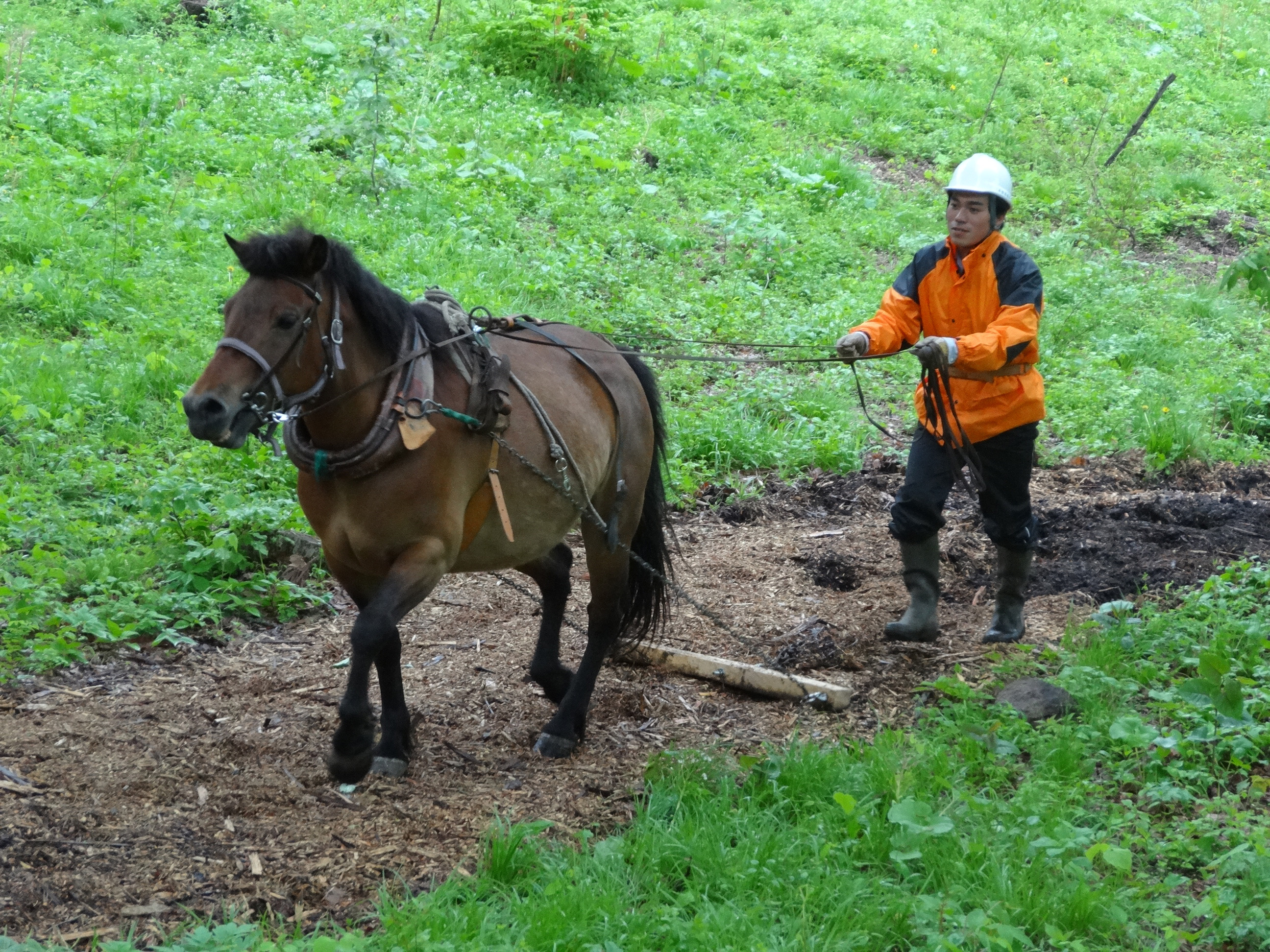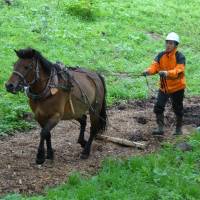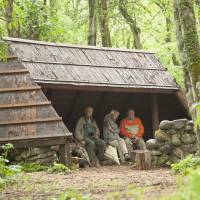I had returned from a three-month trip to the Canadian Arctic and was in Vancouver, meeting up with family and friends before returning to Japan.
One of those friends was Wilf Wakely, who I'd known since 1975 when I was the assistant manager and he was the designated "senior host" of the Canadian Pavilion at the International Ocean Exposition in Okinawa. Afterward, Wilf went on to get a law degree and work with the Canadian Embassy in Tokyo — and, to my surprise, to represent the artist and environmentalist Robert Bateman, a man I greatly admired.
On that occasion in the late summer of 1992, Wilf told me that Robert, or "Bob," was going to have an exhibition at a venue in Tokyo owned by a billionaire developer whose reputation was clouded by his involvement in the construction of golf courses and resorts, most of them detrimental to the environment. He was the last person, as far as I was concerned, with whom Bateman should have his name linked.
"Will you tell Bob to his face?" asked Wilf.
"Sure, but I don't see how — I'm on a plane back to Japan tomorrow."
Early the next morning, Wilf met me with a chartered floatplane just by my hotel on Vancouver Harbor, and we flew out to Saltspring Island, one of the Southern Gulf Islands in the Strait of Georgia between the British Columbia mainland and Vancouver Island.
Shortly after, the three of us were sitting down having coffee in Bob's wonderful house overlooking the sea, with his artworks all around, a little waterfall and stream running through the middle of the house — and even otters living in the basement.
I told Bob what I knew to be true, about the many rumors flying around in Tokyo, and why he should not allow himself to be linked to that developer. Then I got back to Vancouver in time to catch my flight to Japan.
The exhibition was a great success — but the venue was changed to the new Place Canada edifice of the Canadian Embassy. Prince and Princess Takamado were patrons, and I was on the committee.
Bob and his wife, Birgit, traveled all over Japan that time due to him being so popular, but I really wanted him to visit Kurohime in northern Nagano Prefecture, where I had started buying up neglected woodland and restoring it to health. But what, I wondered, could I offer to entice the great artist there, compared to the mighty ancient cedars of Yakushima, or the lovely dancing cranes of Hokkaido?
"Bob, what if I said I could put a sleeping Japanese dormouse into the palm of your hand?"
"We'll come," he said.
The dormouse, fast asleep and in a little furry ball, had fallen out of the old thatch on the roof above our charcoal kiln when we were fixing it ready for the coming winter snows. Mr. Matsuki, our forester, lined a big old pot with soft dried grass, and let the little dormouse slumber on in peace in a corner of his hut, with a perforated lid on the varmint-proof pot so it wouldn't suffocate.
I know it's not strictly legal to touch an endangered species, but there were foxes, martens and weasels around, and we wanted the little creature to survive. If we had just tucked it back into the new thatch, survival was unlikely.
Anyhow, no trouble came of it, the dormouse survived — and it is immortalized in Bob's sketchbook since he did indeed spend a couple of days with us in Kurohime, and we have been in touch and good friends ever since.
Bob's wife, Birgit, is absolutely charming; an artist, greatly fond of nature, enthusiastic about life, and very easy to be with. Bob is softly spoken, but very powerful in his statements about nature, education and the future of the planet. He is never abrasive, and influences millions of people all over the world. In fact, there is no man that I admire more, whether for himself or his superb art and many insightful essays — or because of all the people and wildlife organizations he has helped.
When Wilf told me earlier this year that the Batemans were coming on another trip to Japan, and that they would like to visit our Kurohime woods again, I was over the moon. Since Bob and Birgit saw our woods in 1992, the space has expanded a lot, and 12 years ago the entire property became the C.W. Nicol Afan Woodland Trust Centre.
But with no dormouse this time, I wondered what we could lay on that would be really special.
As it happened, the Batemans' arrival in Kurohime on May 26 coincided with a week of intensive activity by our trust in the adjoining national forest. As we did last year, we were trimming out hundreds of densely crowded cedars and using horses to extract the logs, as was quite normal in Japan up to 40 or so years ago. Now, there are only six active horse-loggers in the entire country, and I had a shrewd idea that Robert would like to see this work firsthand.
Another point of attraction was that apart from the two heavy Percheron horses that also toiled in our woods last year, we could show the Batemans a smaller native Kiso horse. Indigenous to Nagano, this is reputedly the oldest breed of horse in Japan and, with only around 150 left, it is listed as being endangered.
Kiso horses are hardy little animals that were bred for working fields, paddies and mountains, although they were also used in war. With their short but very strong legs, and stout bodies, they are better suited to the cold snowy winters of this region that the likes of those magnificent Percherons.
The old Imperial Army almost succeeded in getting the Kiso breed wiped out, favoring larger, long-legged horses for the cavalry. In fact, the military ordered that all Kiso stallions should be gelded — though fortunately some being kept in out-of-the-way places avoided the chop.
Now, with us being a Nagano-based trust, we have made it part of our mission to bring horses back into the forest both as working partners and so we can offer "horse therapy" to the many groups of youngsters and others for whom it can be a real life-changer.
Consequently, we have been talking to Takeru Nakagawa of the Kiso Horse Preservation Society about the possibility of getting a stallion and a mare once the stable we're planning is built, we've got our dedicated horse person, and we've deal with all the things that need to be seen to before we take on this great responsibility.
In the meantime, Mr. Nakagawa said he would bring one of his Kiso horses to Kurohime to show us what they could do — and when he did it was, for me, love at first sight.
Sora is a 12-year-old mare trained to pull carts, but she did her best hauling one log at a time from the woods with all the power of her 400-kg body — compared with the 1,000-kg might of the big boys, who hauled three logs at a time. Sora, with a golden-brown coat, a long, dark-brown mane and the most soulful eyes you can imagine, is so sweet and attractive that I wished she could have stayed longer.
It was pouring with rain on May 26, but the Batemans never uttered a word of complaint as the conversation and discussions flowed and blossomed. We walked in the woods, saw the horses and their human partners and had a great dinner of local foods at the Koarai Pension. Then they asked if they could stay on for another day and night, which delighted me no end.
As luck would have it the weather the next day was glorious; the greens even greener, the flowers even brighter, and the birds trilling happily.
For the Batemans, theirs had been a very busy trip involving them traveling all over Japan on a tight and meticulously managed schedule, with many, many people to meet. I also have to travel a lot, and at times I certainly get "peopled out" and just want to be left alone for a while. So, although Robert is as spry as ever even though he was born in 1930 and is 10 years older than me, I guessed that he and Birgit wouldn't mind some quiet time, just the two of them, wandering among the trees.
Our woods have well-marked paths, soft with wood chips, and about 200 meters from the Woodland Trust Centre we have a nice lean-to shelter that acts like a big ear, gathering sounds from the forest while sheltering listeners from the weather. We laid sheepskins and a bright Hudson's Bay Company blanket in the shelter, stocked it with flasks of hot and cold drinks — and delivered a picnic basket at lunch.
Meanwhile, one of us quietly checked on them from time to time. They lazed around, took walks as they wanted, photographed and sketched, heard the merry songs of tree frogs, saw a hunting falcon — and even took a nap. When we drove them to Nagano Station at 11 the next morning, they both said that it had been one of the best days of the whole year, and that it was the first time they had been left alone in the woods of Japan.
As for me, I'm looking forward to visiting the big Bateman beaver pond on Saltspring Island — just as soon as I can.



















With your current subscription plan you can comment on stories. However, before writing your first comment, please create a display name in the Profile section of your subscriber account page.